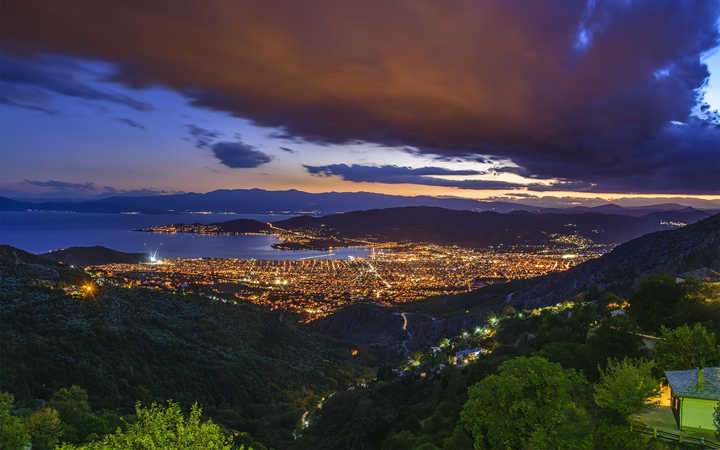At 203 miles (326 km) north of Athens, the port city of Volos is roughly half way to Salonika from Athens, in the center of Greece's Aegean coastline. It's the capital of the regional unit of Magnesia, which is part of the larger administrative region of Thessaly.Milk of Magnesia and the region of Magnesia are completely unrelated, by the way. Milk of Magnesia is so-named because of its magnesium content, whereas Magnesia in Greece is named after an ancient tribe that lived in the region, the Magnetes, who fought at Troy.
This city of 150,000 hugs the shoreline of the Pagasetic Gulf just below the foothills of Mt. Pelion, land of the Centaurs. This mythic being, who has the torso of a man united to the body of a horse, is said to have been created when a man named Centaurs mated with Magnesian mares. The Centauromachy, or Battle of the Centaurs, was commemorated on the Parthenon metopes (Parthenon Marbles, now in the British museum), by the classical sculptor Phidias.
The site Volos now occupies was the location of three ancient cities, one of which, Iolcos, was the home of the hero Jason, who, on the ship Argo, with his companions the Argonauts, sailed off to find the Golden Fleece. This is one of the oldest Greek myths. It was known by Homer in the 8th century. BC. Jason was trained for 20 years by Cheiron, the king of the Centaurs. Cheiron, who also mentored Achilles, taught Jason how to be a hero. One of the foundational stories of Western Literature, elements of this myth have been reworked in many stories, plays and novels over the centuries.
The modern name "Volos" probably derives from "Iolkos," Jason's city. West of Volos are the Neolithic ruins of Dimini, dating as far back as 4,000 BC, and Seskio, which has the oldest acropolis of Greece, dated to 6,000 BC. After a brief ownership by the Serbs, the Ottomans took the city from the Byzantines in 1393, and stayed there until the Greek army marched into it in 1881.
Volos is a beautiful city in beautiful place, overlooking the Pagasetic Gulf, with the bulk of green, forested 5,000-foot (1500 meter) Mt. Pelion- where the centaurs lived- dominating the eastern skyline. Pelion, named after King Peleus, the father of Achilles, is a highly popular destination, with its hiking trails and stone-paved pathways providing access to hidden coves, numerous beaches, artesian springs, and various streams. The mountain is very well-watered, and features ski resorts for winter sports, as well.
The city has a well-developed tourist infrastructure with all kinds of amenities. The waterfront is of special interest. Ferries leave for the forested Sporades Islands frequently, and the seafront is famous for its tsipouradakia, small taverns selling tsipoura, a sort of high-octane ouzo served in tiny bottles, and its mezedes, or food tidbits. Tsipoura goes down smoother than ouzo, as the distillation process is more refined.
People say Volos has the best mezedes in Greece. Fishermen who had come over from Asia Minor in 1922 after the forced population exchange would lounge around the various establishments on the waterfront, sip tsipoura, and nibble mezedes. A demand for ever more inventive variations of the snacks arose, and a kind of competition took place to see who could concoct the tastiest mezedes.
They would offer treats such as grilled portions of every kind of seafood cooked in every fashion imaginable, fried oysters, mussels cooked in red sauce with cheese (called media saganaki), shrimp prepared the same way, octopus grilled or simmered in a wine sauce, tiro kafteri (hot-spiced cheese) to spread on fresh bread, grilled sardines, and slices of feta cheese with olive oil drizzled on it and sprinkled with oregano.
After indulging in mezedes and tsipoura, a visitor can take a stroll down seaside Argonauts Avenue, past the forest of masts of docked pleasure and fishing boats, to the port at its western end, the sea stretching of to the Sporades Islands. Here one can find a reconstruction of the Argo, which was built with guidance from ancient nautical manuscripts.
Volos offers several miles of bike lanes for cyclists. Because the city has few hills, many locals use bikes to get around. Parked cars often block the bike lanes, however, but locals use alternative routes and move from place to place quite comfortably. A number of streets in the city center have been turned into pedestrian walkways, many of which are bordered by cafes.
There are a number of interesting architectural jewels in Volos, the most well-known being the Church of Agios Constantinos and Eleni, a massive edifice built on the seafront and used as a reference point by locals and visitors alike. The Castle of Volos, a walled town in the neighborhood of Paiea on the western side of Volos, was built in the 500's, AD, and was the center of the city's shipbuilding industry for centuries. Goritsa Hill offers a panoramic view of the city from its 650-foot (200 m) summit.
In 1903 a rail line was built from Volos to Mt. Pelion. Known as the Moutzouris, it is one of the narrowest-gauge railroads in the world. The steam-powered train travels at only 15 miles (25 km) an hour, passing over scenic stone-arched bridges and through tunnels as it climbs the mountain for a distance of 9.5 miles (15 km), passing through the land of the centaurs and affording passengers a spectacular view of Volos, the sparkling waters of the Pagasetic Gulf, and the distant headlands. At Milles, the train's terminus, there are tavernas and guesthouses. There is time to take in the sights before the train heads back down to Volos.
Day trips to the nearer of the Sporades, the greenest islands in Greece, are accessible from the port. If anyone has seen the movie Mama Mia, he has seen what the Sporades are like. There are also swimming beaches outside of Volos along the coast of the Pelion peninsula to the east.
Volos is a favorite destination of Greeks, and worth a visit for those going on to a more extended stay in the Sporades.












